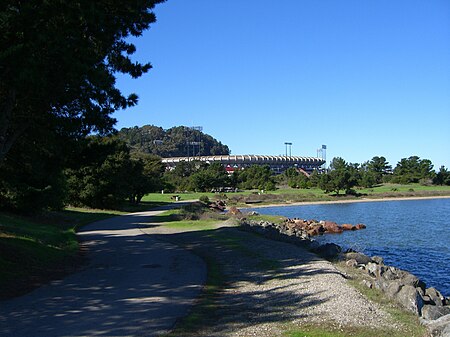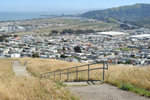Candlestick Point State Recreation Area

Candlestick Point State Recreation Area (or simply Candlestick Point) is a state park unit of California, United States, providing an urban protected area on San Francisco Bay. The park is located at the southeastern tip of San Francisco immediately south of Hunters Point and 2 miles (3.2 km) north of Sierra Point in Brisbane. This 170-acre (69 ha) landfilled area was intended to be used during World War II as a shipyard by the United States Navy. However it was abandoned as the war ended. Without government controls, the area was used by nearby residences as a garbage dump. In 1973 the California State Legislature purchased the land with US$10 million and in 1977 voted to turn this area into a California State Park. After the designation Candlestick became the first urban recreation area in the state. To this day Candlestick remains as a major recreation area in San Francisco, offering a wide view of the bay. The park features various picnic areas, two fishing piers, fitness courses as well as hiking trails. This park is also a popular area for windsurfing due to strong and regular winds.Candlestick Park, the former stadium of the San Francisco Giants and San Francisco 49ers, was also located next to Candlestick Point. There are several competing theories for the origin of the point's name. Several sources claim it was named for Candlestick Rock, an 8-foot (2.4 m)-tall pinnacle rock once located nearby at the high-tide line. Others claim it was named for the long-billed curlew, which was once plentiful in the area and also known as the candlestick bird. Still others claim the name derives from the 19th-century practice of burning abandoned sailing ships in the bay; as they sunk their flaming masts resembled lighted candlesticks.
Excerpt from the Wikipedia article Candlestick Point State Recreation Area (License: CC BY-SA 3.0, Authors, Images).Candlestick Point State Recreation Area
Donner Avenue, San Francisco
Geographical coordinates (GPS) Address Nearby Places Show on map
Geographical coordinates (GPS)
| Latitude | Longitude |
|---|---|
| N 37.7096537 ° | E -122.3802486 ° |
Address
Donner Avenue
Donner Avenue
94188 San Francisco
California, United States
Open on Google Maps






